by Stephen Ormrod and Nigel Schofield, Edwards
EXECUTIVE OVERVIEW
Far from disappearing as a result of the introduction of solid state electronics, vacuum pumping technology today plays a key supporting role in at least 70 general manufacturing applications, spanning a wide range of industries. In particular, semiconductor, flat-panel display, solar manufacturing, and scientific instrumentation industries have driven recent developments in vacuum technology and are likely to continue to do so in the immediate future. This article describes the future of vacuum technology and summarizes the design changes that will likely be needed.
At the beginning of the 20th century, the use of vacuum as an industrial process technology was just emerging, driven by the invention of the electric light. The introduction of the radio and television, both of which depended on vacuum tubes, helped expand that demand. Then, in the 1950s and 60s, the growing use of solid state transistors led many industry pundits to predict the imminent demise of vacuum processing — especially in the electronics industry. As we near the end of the first decade of the 21st century, however, vacuum process technology is alive and well, and solid state electronics has become the technology’s biggest driver.
Today, the market for vacuum components (as opposed to vacuum systems that use those components) is approaching $6 billion (based on ISVT 2007 [1] figures and Edwards’ internal sources) and has been growing steadily. Pumping and pumping services comprise about two-thirds of the market, with semiconductor fabrication being the largest single sector. Approximately half of the current demand for vacuum components comes, not surprisingly, from Asia.
Key applications driving process technology
More than 70 general industrial applications use vacuum processing, with new ones emerging on a regular basis. These, in turn, can be broken down into hundreds of specific applications, which can have very different requirements. Specifically, electronics, flat-panel displays, solar manufacturing, and scientific instrumentation are likely to drive developments in vacuum technology in the coming years.
Semiconductors. Decreasing device sizes and the increasing wafer size have fueled fab vacuum requirements through the need for higher gas throughput and the increasing variety of precursors and process by-products. This phenomenon will likely continue to drive increasing demand for process vacuum and bigger pumps. In addition, the introduction of new materials into semiconductor processes — the so-called "walk along the periodic table" — as well as new physical processes, such as atomic layer deposition (ALD), have introduced new pumping challenges that will continue to need addressing.
Flat-panel displays. The widespread adoption of large, flat-screen TFT-LCD TVs has driven demand for increasingly bigger pump sets. The latest Gen 10 lines are using 40 pumps to deliver a throughput of 2 million liters per minute per tool. While such pumps have already doubled in size to meet flat-panel manufacturing requirements, there is additional demand for pumps three or four times larger (Figure 1).
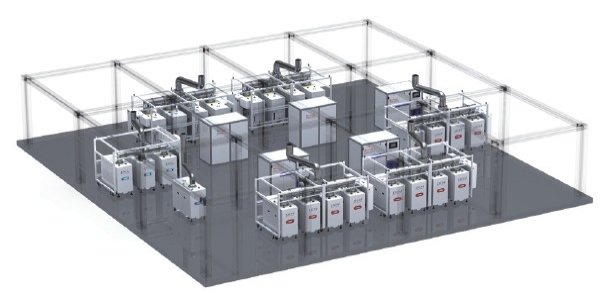 |
| Figure 1. A 2 million L/min pump set for a typical Gen-10 flat-panel tool. |
Solar cell manufacturing. As solar power generation moves toward cost parity with more conventional power sources, solar cell manufacturing promises to become another key technology driver, especially the demand for larger pumps and pumps capable of handling aggressive chemistries. While to date solar cell manufacturing has primarily fueled increased demand for products already used in semiconductor, flat-panel display, and general industrial applications, solar application-specific requirements are emerging. A single-chamber silane deposition pump set, for example, must also balance the conflicting requirements for high hydrogen flows and very high corrosion resistance.
Scientific instrumentation. In this application, mass spectrometry tools, which are in high volume demand, are driving vacuum technology development. Pumps currently in use are being pushed to the edge of their operating envelope to achieve increasingly higher throughput. While these pumps have remained approximately the same size, inlet speed has almost doubled, and total pump throughput has increased by factors of ten. Pump cost has also been reduced.
Current vacuum technology
In the middle of the 20th century, almost all primary pumps used oil-sealed rotary vane mechanisms. By the end of the century, the semiconductor industry had driven the need for a change in pumping technology. The aggressive chemicals used in semiconductor processing tended to attack the oil that was used to both lubricate and seal pumps, causing them to seize up. This challenge drove the development of the dry rotary pump and the magnetically levitated turbo pump.
Dry rotary pumps require extremely tight running clearances and multiple stages to achieve a practical level of vacuum. The additional cost of these machines, however, was more than offset by the benefits they offered to semiconductor manufacturing. Dry pumps use a variety of pumping mechanisms — roots, claw, screw and scroll. None of these are new concepts, but modern machining capabilities made it possible to produce them at a realistic cost. Each of these pumping mechanisms has been successfully deployed and each has its own advantages and disadvantages in a given application. The scroll pump, for example, is unique in its ability to economically scale down to much smaller sizes.
Turbo pumps use rapidly spinning blades to impart direction to gas molecules, propelling them through multiple stages of increasing pressure. Early turbo pumps, which used oil-lubricated bearings, were used extensively in the etch process in semiconductor manufacturing. The acids from the etch process tended to degrade the oil, frequently causing pumping failures in as little as a few weeks. This problem was solved by introducing magnetic bearings to levitate the pump drive shaft and eliminate the need for lubricating oil.
The latest primary pumping mechanism to be introduced is the regenerative pump, which uses a single, high-speed rotor to impart momentum to the gas, compressing it through several stages to atmospheric pressure. While other non-displacement pumping mechanisms — using acoustic waves or plasma, for example — can be conceived, it remains to be seen if they can be successfully commercialized (Figure 2).
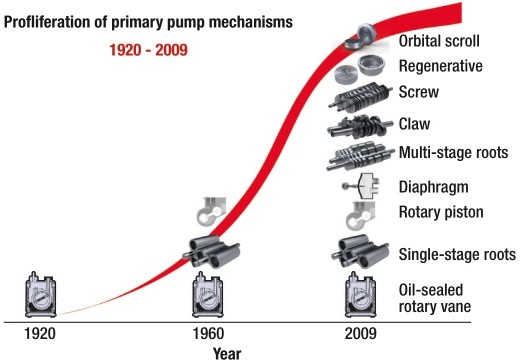 |
| Figure 2. Three snapshots in time. |
Future pumping technology
Predicting future technology developments is always risky. There are, however, certain vacuum technology trends — particularly in the areas of shaft speed, management of pumping power, and computer modeling — that can be discerned with some degree of certainty.
Shaft speed. When dry pumps were first introduced, they typically operated at around 3,000 to 3,600 rpm. Today’s dry pumps use electric drives to run considerably faster, typically 6,000 rpm for claw, screw, and multi-stage roots pumps.
Increasing a pump’s rotational speed delivers a number of advantages. It makes it possible to build more compact pumps and motors, with less internal leakage, which in turn enables a reduction in the number of pump stages required. Combined, these benefits help reduce the overall pump cost.
Historically, the pump shaft speed has steadily increased (Figure 3). There is, however, a fundamental limit to the maximum speed that can be achieved by a particular pumping technology. This limit is not due to materials or bearings technology, but is governed by conductance. Getting a gas to flow into a space takes time, especially at low pressure.
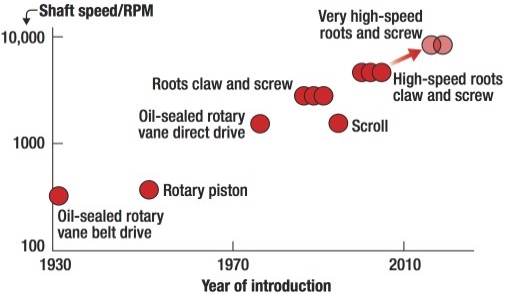 |
| Figure 3. Shaft speeds for primary pumping mechanisms. |
Each type of pumping mechanism has different characteristics in terms of the size and shape of volume to fill. A scroll mechanism, with its narrow, ported inlet and a long, thin volume space, is one of the slowest pumping mechanisms to fill. Performance does not increase in proportion to increases in shaft speed. Most scroll pumps operate at just 1500 rpm. A roots mechanism, by contrast, has a very large opening and a short volume length, enabling it to fill quickly and allowing efficient use of higher shaft speeds.
The conductance ceiling for roots and screw pumps is probably ~15,000 rpm. Achieving this speed, however, will require incremental improvements in materials, bearings, and drives. It is likely that we will reach the conductance ceiling for most of the current primary pumping mechanisms within the next decade, although some, such as roots and screw mechanisms, may prove more durable than others.
Turbomolecular pump conductance is governed by blade speed and molecular velocities. Turbo performance has been limited primarily by the maximum speed the bearings and rotor can withstand. The industry is looking for new materials that are lighter and stronger to enable increased speed. While this pump type may be reaching its conductive limit on heavier gases, it is far from reaching it for lighter gases, such as hydrogen. This may take a much longer time to achieve.
Managing pumping power. Pump consumption is one of the key contributors to pump cost of ownership. The amount of power a vacuum pump consumes depends on its volume ratio and inlet pressure. A perfect pump (having a variable volume ratio and no parasitic losses) would operate as shown by the green line in Figure 4. At atmospheric inlet pressure, the pump is simply moving gas from one place to another with no compression and, therefore, no work or power. At low vacuum pressures, the pump takes in virtually nothing — just a few molecules; compressing these up to atmospheric pressure again takes virtually no power. Somewhere in between, however, a substantial amount of energy is required. This point is ~300mbar for air.
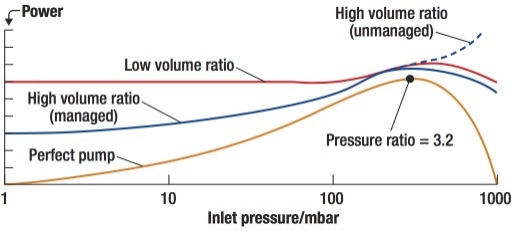 |
| Figure 4. Power consumption is a function of inlet pressure and volume ratio. Power consumption reaches a maximum for air at a pressure ratio of 3.2, about 300mbar. |
The problem for a pump designer is that achieving the green line requires a pump with an inbuilt volume ratio that is matched to the pressure ratio across the pump — and that is always changing. An oil-sealed rotary vane pump actually achieves this remarkably well due to the non-return valve on the mechanism exhaust. A dry pump running at high shaft speeds can’t use a non-return valve because it is too slow to operate. Its multiple stages effectively define a fixed volume ratio across the pump (large inlet stages followed by smaller exhaust stages). At a typically low volume ratio of ~ 3:1, the exhaust stage is relatively large and, therefore, doesn’t become a restriction when the pump needs to rough at atmospheric pressure. This prevents an overload situation, but as a consequence, the power curve is always high (see red line, Fig. 4). It is clearly wasteful, especially if a pump spends most of its life operating at low pressures.
More recent dry pumps are now using higher volume ratios to achieve a lower power at low pressures, as shown by the blue line in Fig. 4; however, the resulting overload must be controlled at high inlet pressures (dashed blue line). To prevent overload, drive electronics can limit the power and slow the pump at high pressures; this works well, but sacrifices pumping speed. Another solution is to introduce a blow-off valve into the mechanism, which relieves the restriction of the small exhaust stages and maintains pump speed. Solving the high-pressure overload allows high volume ratios with much improved power consumption, and this will drive future pumps to increasingly high-volume ratios. Practical future pumps will, therefore, come much closer to the theoretical line.
Computer modeling of vacuum pumping. We can now use computers to accurately model vacuum chamber volumes, pipe conductances, outgassing from the walls, and suction from a pump. We can also predict flow behavior in a range of different regimes, such as turbulent, laminar, transitional, and molecular flow. Putting all this together, we can solve a set of equations that predict the performance of a complete vacuum system.
Typically, this might be the pump-down of a process chamber, initially in turbulent flow, moving to laminar and then transitional, with outgassing playing an ever-increasing role. The output would be a pump-down curve. The precision of this data is critical, especially for large pumping systems where it is imperative to avoid the cost of too much pumping.
These complex models calculate transient as well as steady state conditions, and can include effects such as adiabatic cooling and the slowing and re-acceleration of a roots blower when initially opened to the chamber. These effects increase the pump-down time and must be taken into account to achieve an accurate model.
Figure 5 compares the latest modeling capability (red line) with actual performance (blue line). The yellow line shows an early Edwards model that did not include transient effects. Modeling now predicts performance in a reliable way and will be increasingly used in the future to optimize system design and minimize power consumption.
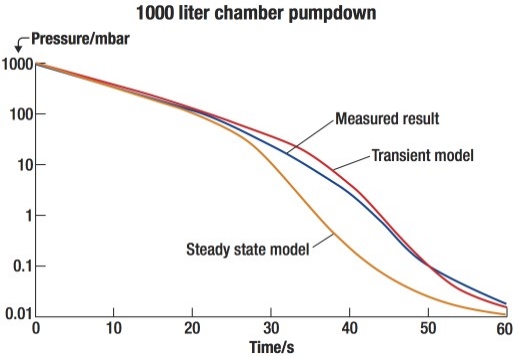 |
| Figure 5. Computer modeling (red line) compared to actual performance (blue line) |
Computer modeling can equally be applied to the stages of a vacuum pump. Such variables as stage size, running clearance, leakage, and conductance can all be taken into account. This allows the simulation of a design and optimization of performance, such as power and speed curve shape. In this way, a pump can be designed for specific duties, such as load lock pumping or processing with hydrogen flows.
CONCLUSION
Vacuum pumps of the future will be more reliable and capable of operating for longer periods of time before requiring maintenance. They will be safer to operate, will occupy less fab space, run cleaner and require less power, as well as generate less noise, vibration, and heat. They will also have improved corrosion resistance and the ability to run hotter when required. As a result, vacuum pumps will be more environmentally friendly — running cleaner and using less power will help reduce their carbon footprint. In addition, they will likely make much greater use of recycled materials and use fewer consumables, thereby helping to reduce overall pump costs. Vacuum pumps will also be easier to clean, repair, and rebuild for reuse.
Likely technical developments will also include higher shaft speeds, and a growing proliferation of pumping mechanisms and combinations of mechanisms to increase performance. Finally, vacuum pumps will incorporate new materials and improved modeling to further improve performance and reduce system and operating costs.
ACKNOWLEDGEMENT
The authors would like to acknowledge F.D. Edwards, who founded Edwards as a vacuum company 90 years ago.
BIOGRAPHIES
Stephen Ormrod holds a PhD in electronic engineering from the U. of Nottingham, UK, and is chief technology officer at Edwards, Manor Royal, Crawley, West Sussex, RH10 9LW United Kingdom; e-mail [email protected].
Nigel Schofield holds a mechanical engineering degree from Imperial College, London, and is a core technology manager at Edwards.
REFERENCES
[1] International Statistics on Vacuum Technology (ISVT) and Edwards estimates; ISVT participants (AVEM, JVIA and EVTA) represent approximately 80% of the global market.


Combined with Japan and Taiwan’s manufacturing technology, ANSON’s hydraulic pump has earned the reliable reputation in local and worldwide dealers.
Thanks for sharing a good informative article on Vacuum processing.
Nice informative post.